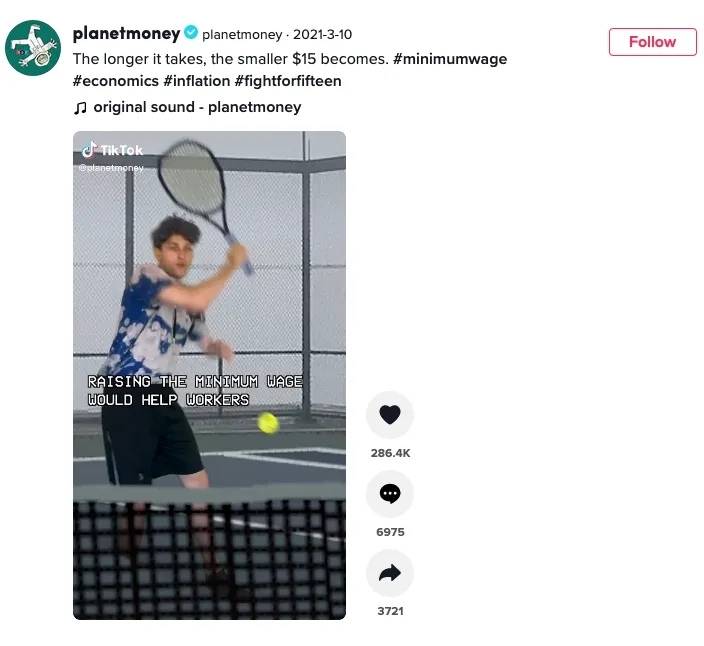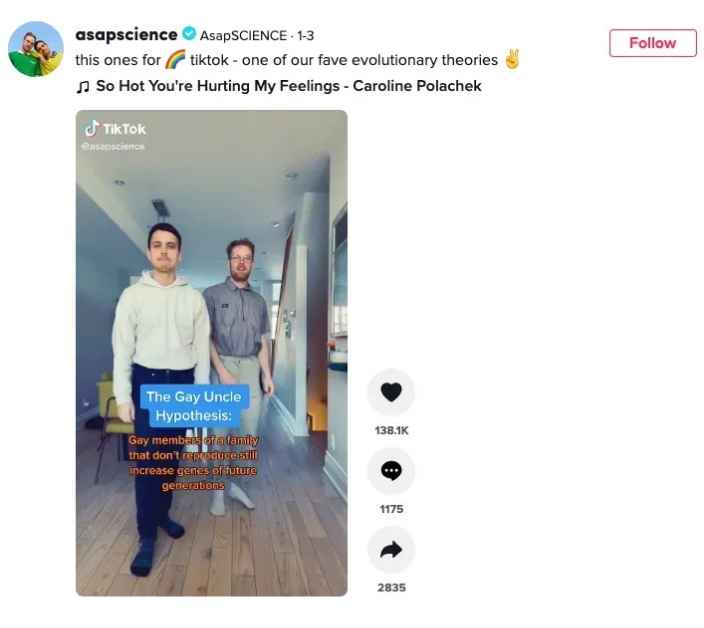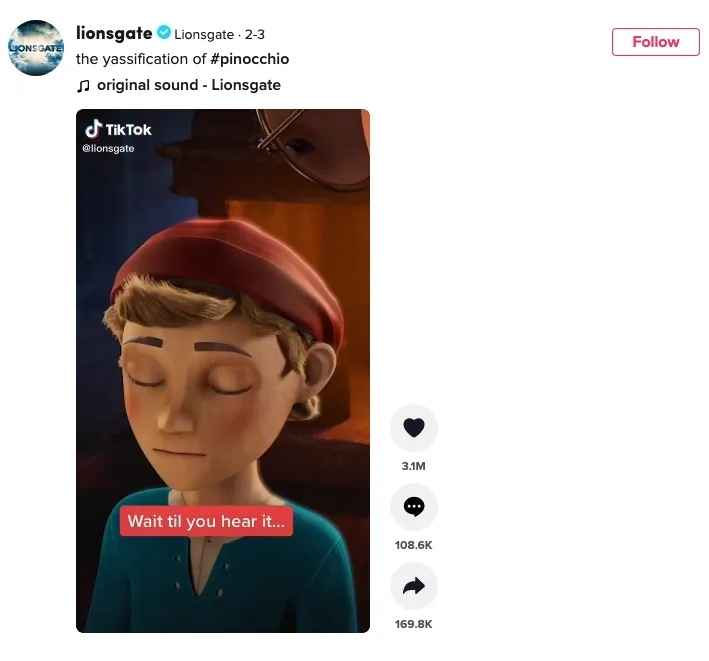Why Your Audiograms Aren’t Working

Why Don’t Audiograms Bring New Listeners?
Social media prioritizes visuals over audio
Platforms like Instagram, Facebook and Twitter are designed to be text or image-first. They’re designed so users can pop them open and scroll no matter where they are, whether they have headphones on or are in public or even while on a Zoom call. And the data backs this up– as much as 85% of scrolling happens with the sound off. That doesn’t bode well for promoting your audio-only podcast on social media. If most people are scrolling through their feeds with the sound off you’re going to have a tough time convincing them of the merits of your podcast using an asset that offers very little visually to keep their attention.
People scrolling through social media are in a snackable and screen mode
And podcasts are not snackable OR screen-first. While most content on social media is bite-size (three minutes long or less), podcasts are comparably a full-size meal (often 20 minutes or more). Social media requires attention and interaction with a screen, and podcasts are decidedly screen-free. This is one of the superpowers of podcasts– listeners can engage with podcasts while multi-tasking and they often engage for much longer than they’re willing to dedicate to other forms of media. But it does present a challenge when it comes to converting social media views into podcast downloads. Someone scrolling through social media is probably not in the mindset to want to listen to a long-form story– and they likely will just scroll past rather than click through to another additional app.
Not everyone scrolling on social media knows what a podcast is
Podcast audiences are growing year over year; however, it is a growing medium and we can’t assume that everyone scrolling through social media will be familiar with what podcasts are and how to listen to them. For audiograms promoted on social media, buyers have to find the right balance between targeting avid podcast listeners, or people interested in their subject matter. (For example, if you have a podcast about the latest season of The Bachelor, do you prioritize targeting Instagram users who have an indicated interest in podcasts? Or users who have an interest in The Bachelor?) In general, it’s always better to preach to the converted– we’ve found promoting podcasts through host-read ads on other podcasts is the most effective way to bring in new listeners. According to The Canadian Podcast Listener, listening to other podcasts was the most common source for monthly podcast listeners to discover new podcasts.
There are too many steps involved to go from scrolling to subscribing
Podcasts are not yet easily embedded into social media, so getting someone to go from scrolling on social media to downloading or subscribing to a podcast requires more steps than most casual scrollers are willing to take. Many social media apps, like Instagram or TikTok, don’t make post links easily clickable, adding another cumbersome step between audiogram and podcast.
One exception to this is YouTube. We have written frequently on this blog about the benefits of sharing your podcast on YouTube, and while I feel like YouTube should arguably not be considered a “social media platform,” I also think it’s important to acknowledge how audiograms are used there. YouTube is powerful for increasing the discoverability and accessibility of your podcast. Using an audiogram as the visual graphic when uploading your podcast episode to YouTube might be a great way to accompany your audio-first content with some visual brand. It’s probably safe to assume most people “watching” your episodes on YouTube are just listening to the podcast while performing other tasks. We recommend this approach to our clients and have seen it work. An example of this is Ford’s Bring Back Bronco .
There are too many podcasts that suck
Okay, I’m getting a little blunt with this last point. But with 2-million podcasts (and counting) available right now, it’s fair to say that there’s going to be a range of quality out there. When everyone and their brother is launching (and promoting) their podcast, it can get difficult to differentiate between what is worth your time, and what is wasting your time. This is why host-read podcast ads can be so powerful– one of the most reliable ways for discovering a new podcast is by recommendation from someone trusted (more about this below). If you have never proven your media production skills, your social media followers will be (understandably) wary about the quality of your new podcast project.
Summary: An audiogram is asking a lot of someone scrolling through their social media feed. With most users scrolling with the sound off, audiograms offer little visual context to quickly capture the small attention spans of scrollers. Many social media users are not familiar enough with podcasts to navigate to their podcast app, and many social media platforms make linking cumbersome. In a crowded podcast market, audiograms do little to prove your podcast’s quality, making clickthrough challenging.
What can you do on social media instead?
Expand on content versus promoting content
Rather than posting to promote the podcast, think of social media as an opportunity to extend the podcast content onto a new platform. You can think of this as repurposing your podcast content for other platforms, but I’m wary of phrasing it that way. This isn’t just cross-posting the same content (à la using a clip from the podcast episode). It’s reimagining how the story or information from your podcast could be shared in a way that feels authentic to the platform where it will be seen. This is easier to explain with examples, and I have a few really good ones.
Planet Money:
Planet Money has done a great job of creating the kind of lo-fi content that matches the kind of content TikTok users are accustomed to. Each TikTok repurposes the concept from an episode of Planet Money in TikTok-first format.

AsapSCIENCE:
Similarly, AsapSCIENCE does an amazing job of repurposing stats, data, and stories from their podcast and YouTube channel into TikTok trends and dances.

Focus only on platforms where your target audience is
Rather than cross-posting the same audiogram across all social media platforms, it can be more efficient and more effective to focus on the platform your target audience is most likely to use. For example, if you’re looking to reach high-achieving professionals looking for business advice, maybe LinkedIn is the best place to focus your energy. If you’re trying to bring in a younger audience, it makes sense to focus your time on developing a strategy for TikTok.
Does TikTok present unique opportunities for podcasts?
I’ve talked a lot about TikTok so far, and that’s because TikTok presents a unique opportunity for podcasts. I mentioned above that most social media platforms are image-first– TikTok is the exception. On TikTok, 9 out of 10 users view audio as vital to the user experience. On other “sound off” platforms, the humor of a meme comes from the repurposing of a familiar image with new text added to give the image new meaning. TikTok subverts this, with the audio being repurposed while it’s the images that change to create new meaning. All of this to say, TikTok presents an opportunity for audio-only podcasts to capture the attention of new audiences.
Musicians have had a lot of success with this on TikTok, creating TikTok challenges and trends with clips of their new songs, causing them to go viral and raising the profile of the artist.

And even Lionsgate has leveraged this, choosing clips with easily meme-able audio and encouraging others to use the audio in their own videos.

Is there a clip from your podcast that could be turned into a viral TikTok meme? Maybe. Just make sure to spend enough time exploring TikTok to understand how trends work and what kind of content does well on that platform.
Explore influencer marketing
My last point is less direct advice, and more a request for some educated experimentation. According to the latest edition of the Canadian Podcast Listener Report, people are still most likely to discover new podcasts through recommendations on other podcasts. BUT a stat that I found interesting shows that 13% of people heard about a new podcast on social media from someone they follow. In comparison, only 1% discovered a new show from a sponsored social media post. It seems that the biggest difference is whether the social media post comes in the form of a recommendation from someone trusted (it’s worth noting that 18% reported discovering a new show from direct communication with someone they know). Whether it’s in a host-read spot on another podcast, a text message from a friend, or a screenshot shared in an Instagram story, it seems that the key factor determining conversion is whether the show is being recommended by someone trusted. So, if you’re still really keen to develop a social media strategy to promote your podcast, perhaps an interesting avenue to explore is influencer marketing. I haven’t seen this done much, but it seems like the opportunity is there to explore. If you’re aware of a social media influencer who loves true crime podcasts, for example, is it possible to get your new true crime show on their radar? How can you make it easy for them to tell their followers about your show? How can you make sure their recommendation comes across as authentic? No matter how much money you put into your sponsored social post, it seems unlikely to drive the kind of results you could see from an authentically shared recommendation from an influencer.
Summary: First and foremost, well-made podcast recommendations from other podcast hosts are going to result in higher conversions than social media posts. But if you are keen on developing a social media strategy for your podcast, there are still lots of ways to use your money and energy effectively. Make sure that the content you post feels authentic to the platform where you’re posting and is the kind of content followers will expect when scrolling through their feeds — otherwise, you’re just wasting your time. Focus on the platforms that make sense, rather than cross-posting on every social media platform. And when working out social media budgets, consider influencer marketing rather than sponsored posts.
Sign up for the Pacific Content Newsletter: audio strategy, analysis, and insight in your inbox.
